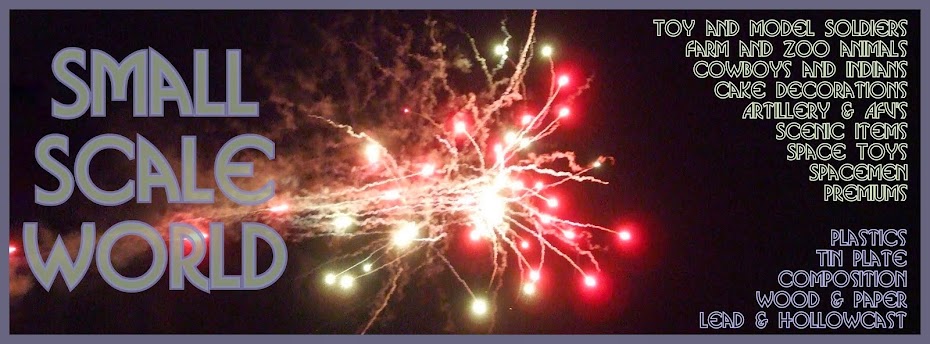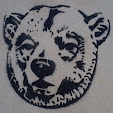 All eight poses, one damaged, they always had silver helmets, but these might have been re-painted? The officer has a plug-in moving arm, and like the Lone*Star ships officer we saw back on Trafalgar day (spanking the surrender-monkeys!), this suffers from 'early-English chalky-plastic syndrome'; that it's usually been separated from it's owning shoulder! There is a thinner slim-calved version of this moulding, see the Plastic Warrior 'special' on Speedwell (ISBN: 1-900898-20-9) for a good image of him. Indeed, the aforemetioned publication is definite reading for any student of these figures.
All eight poses, one damaged, they always had silver helmets, but these might have been re-painted? The officer has a plug-in moving arm, and like the Lone*Star ships officer we saw back on Trafalgar day (spanking the surrender-monkeys!), this suffers from 'early-English chalky-plastic syndrome'; that it's usually been separated from it's owning shoulder! There is a thinner slim-calved version of this moulding, see the Plastic Warrior 'special' on Speedwell (ISBN: 1-900898-20-9) for a good image of him. Indeed, the aforemetioned publication is definite reading for any student of these figures.Although sculpting on these is marginally better than the Trojan set, it must be said; the animation is pretty abysmal. The grenade thrower seems to be hurling a piece of 1940's fitness equipment, or a detachable whisk-head, while the machine gun has clearly been liberated from a fireworks-night 'Guy', having been made from three sticks and a gift-wrapping card tube! But they were ONLY toys! Not much else to note, the different treatment of the bases being the only obvious point and very much in-line with the evolution of Trojan painting.
 Far right is the greenish 'Field Gray' version I mentioned above, a mate of mine has quite a few of these and the helmet camouflage is both standard and the same as the Speedwell copies of the Timpo GI's. To the left is the multi-coloured granule moulding that is so common in early plastic production, going right back to the very early days of Bakelite and Ivorene ashtrays and pen barrels! Unpainted examples in sand and multi-colour turn up with only slightly less frequency than painted, but the green/grey ones always seem to have at least the remnants of a paint-job.
Far right is the greenish 'Field Gray' version I mentioned above, a mate of mine has quite a few of these and the helmet camouflage is both standard and the same as the Speedwell copies of the Timpo GI's. To the left is the multi-coloured granule moulding that is so common in early plastic production, going right back to the very early days of Bakelite and Ivorene ashtrays and pen barrels! Unpainted examples in sand and multi-colour turn up with only slightly less frequency than painted, but the green/grey ones always seem to have at least the remnants of a paint-job.Behind is one version of the stretcher team, taken from Timpo, via Kentoys and spread - with variations - throughout all these early British producers; Kentoys, Speedwell, Trojan, Una, VP and possibly/probably Benbros and Paramount. The reason I've included it here is that despite the British Guards Brigade/post-war Tommy Atkins' 'piss-pot', I suspect this is meant to accompany the desert version of these Germans. [No - it's the 14th Army stretcher team from Trojan!]
I also have the same multi-maker British-helmeted mortar No.2 in sand yellow plastic, yet I've never seen other 'Allied' figures in that colour. Also, the same mate has boxes of all these makes figures, with a similar dearth of sand-yellow, so the guess is; the sandy Stretcher and Mortar teams were included in one of the bigger German boxed sets by Speedwell to increase play value? Maybe one of the Coronet series in the above mentioned PW 'Special'.
 Close-up to show the distinctive base on most (but not all) of these figures. Indeed in the lot that came-in in the Autumn, from which these are taken, were large numbers of the multi-coloured figures (badly painted in a black scheme, probably home-painted) with flat bases, which may well have been sold as Trojan or Kentoys, or included in boxed sets by either, or Una/VP?
Close-up to show the distinctive base on most (but not all) of these figures. Indeed in the lot that came-in in the Autumn, from which these are taken, were large numbers of the multi-coloured figures (badly painted in a black scheme, probably home-painted) with flat bases, which may well have been sold as Trojan or Kentoys, or included in boxed sets by either, or Una/VP?


No comments:
Post a Comment